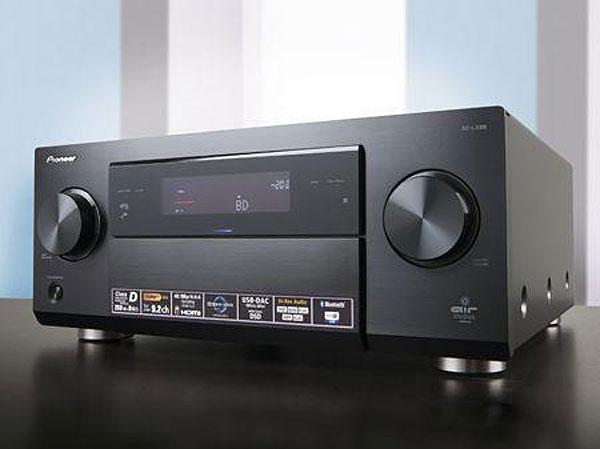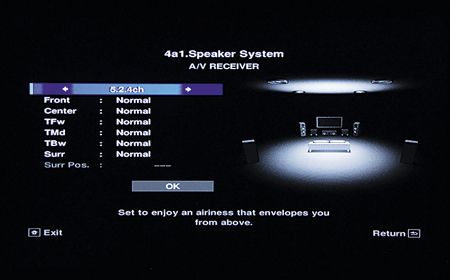Pioneer SC-LX88 review

 Pioneer’s new flagship AVR comes to the HCC test bench fresh from its Dolby Atmos firmware upgrade, bristling with features that will have both music and movie fans salivating. It's a lavishly-engineered top-flight powerhouse that deserves an audition if you're upgrading your setup – although it does have one curious flaw...
Pioneer’s new flagship AVR comes to the HCC test bench fresh from its Dolby Atmos firmware upgrade, bristling with features that will have both music and movie fans salivating. It's a lavishly-engineered top-flight powerhouse that deserves an audition if you're upgrading your setup – although it does have one curious flaw...
I'll get to that flaw soon enough. In the meantime, the facts. This is a 9.2-channel receiver with 32-bit ESS Sabre DAC and all-digital amplification throughout. On the audio side, Pioneer claims a very healthy 220W-per-channel output and sonic tuning by AIR Studios. On the video side, you have full 4K upscaling and power-off HDMI passthrough (but not HDCP 2.2 support) for those quieter TV watching moments. You get eight HDMI inputs (one with MHL) and three outputs, multizone setup and plenty of legacy connections including an MM phono stage. Although, as the turntable is rapidly becoming the new must-have audio accessory, maybe that is not as 'legacy' as it once was.
In fact, this Pioneer does a lot more than give a passing nod to those buyers who like their audio sans pictures. Its USB input connects easily to any PC or Mac without drivers, and it will accept pretty much any audio format, including up to native DSD. Moreover, Pioneer has used the high-speed processing of the DAC to enable upsampling of native digital audio to 192kHz/32-bit before hitting the amplifier stage in an effort to ensure the most accurate music reproduction. This is a well regarded feature common to hi-fi-specific two-channel DACs and you can always defeat the function if you want true in/out purity.
Streaming music from 'net-connected DLNA devices or a Windows8 PC is a doddle, and the SC-LX88 comes with vTuner internet radio and Spotify Connect on tap, as well as AirPlay and iPod compatibility via USB. For a bit of instant music gratification it also offers apt-X Bluetooth. A Wi-Fi adapter is included in the box so you don’t need to dig out an Ethernet cable to access the network features either (although I recommend it for robustness – particularly when doing a firmware update).
That all reads like a wish-list for a modern stereo amplifier, so you can see this Pioneer aims to have a very wide appeal. Adding to its all-round allure is the moderately stylish design, solid-feeling build and phalanx of logos stuck to the front fascia. Interestingly, though, the SC-LX88 dumps the THX Ultra2 certification of the outgoing SC-LX87. Given that waving a THX badge doesn’t really have the impact it used to, this is probably no surprise as flourishing one comes at a cost to manufacturers.

For those looking to be so much at the cutting-edge of AV tech that they're constantly putting plasters on their fingertips, the headline feature here is Dolby Atmos processing. But, hang on! As a 9.2-channel amplifier the Pioneer can only drive nine of the speakers in an Atmos system – 5.1.4 or 7.1.2 are both possible natively.
Now, you would have thought an add-on stereo amp might bag you a full-fat 7.1.4 Atmos system via the Pioneer's 11.2 channel pre-outs. Alas not. The brand says the SC-LX88 only has the capability for 9-channel ‘processing,’ meaning this is rather more skinny than the full-fat we hoped for.
That will leave some of you in a bit of a dilemma – mainly those already with a traditional 7.1 array and a desire to add four height speakers. Do you instead go 7.1.2 or 5.1.4? I auditioned the latter – having gone through all sorts of domestic upheaval to fit four ceiling speakers, I was damn well going to use them – and discovered it makes Atmos really come alive, even if there is something of a hole in the soundstage behind the sofa with rear-backs missing.
For that fully-fledged Atmos experience, an alternative is to check out a rival model at around the same price point. Yamaha, for instance, assures us that its RX-A3040 will provide 7.14 Atmos using its nine channels plus an additional stereo amp.

Pioneer's amps are hard to knock when it comes to simple setup and sheer usability. The SC-LX88 is a breeze to get running, even if you have no prior knowledge of using an AV receiver. Part of this class-leading package is the Pioneer AV Controller app. Now in its fifth generation, it looks fantastic, is as slick as an oiled panther, and contains an inspired wiring navigator sub-app that leads you (excuse the pun) connection-by-connection through the hooking up of your speakers and sources.
With the supplied microphone positioned in the listening position (on top of your head is still a good suggestion), Pioneer's automated MCACC Pro setup is two button clicks away and requires just one pass in one mic position. Five minutes later the job is done. The results seemed spot on and it easily detected a ceiling speaker that some muppet installer (well, me) managed to wire out of phase.
I guess Pioneer is expecting you to use the app for much of the day-to-day operation as the remote control is nothing special. It’s functional, learning and partly back-lit in red, but it remains a simple stick full of little buttons. I do, however, appreciate the one-button access to channel levels, as I am a great fan of running with a level balance that sounds right rather than simply measures right. Want some more overhead action? Simply add a bit of gain to those channels.
We are light on consumer Dolby Atmos-encoded material at present, and there doesn’t appear to be a flood on the horizon any time soon. DTS is ensconced with most of the major studios and has become the sound format of choice for BDs in the last few years. Of course, Dolby hopes to turn that around with Atmos (more through its awesome Atmos studio mastering tools than the Blu-ray potential) but it’s going to be a slow burn.
However, there is overhead sound hope for us yet. Dolby has replaced many of its confusing iterations (Dolby Pro-Logic IIx etc) with a capture-all ‘Dolby Surround’ mode as part of the Atmos specification. This maps the native channels (two and up) from incoming sources onto your actual speaker configuration. Overhead channel information is processed virtually out of the incoming mix, so don’t expect precision effects, but the mode does deliver an ambient and generally subtle effect with vanilla soundtracks, which works a treat in creating a more three-dimensional soundscape from any source.
Having tried a few old 5.1 chestnuts, Dolby Surround mode became the default soundfield for action movies as it delivers a bit more immersion than native decoding. As noted it is subtle – unless you up the overhead channel levels a lot – but it will have you scanning back through your old DVD and Blu-ray collection to revisit old movies with a new sonic dimension.

So how does the Pioneer SC-LX88 actually sound? Well, it’s a lively performer for sure, with crisp detailing and an up-front nature that delivers action movies with all the gusto they deserve. I struggled with bass management due to having something of a mish-mash of speakers in my 5.2.4 set up, each with very different LF output. The Pioneer only allows you to set a blanket crossover frequency for all speakers labelled small rather than individual channel crossovers. This means that the system (manually and automatic) sets the highest crossover required by any one speaker for all channels.
The issue is exacerbated by Atmos channels. Whether you use in-ceiling or up-firing Atmos speakers, neither design has very extended LF performance. In my case that meant the system crossed over to the subs at 100Hz, which rather defeated the benefit of my massive centre channel speaker with its three 8in bass drivers. As such, dialogue didn’t have the absolute richness I have become used to. If you are using similar-sized speakers all round that issue will be something of a moot point.
And there is certainly nothing lightweight about the way the SC-LX88 handles bass. A lad's night in with back-to-back Fast and Furious movies proved a stomach-churning festival of LFE from end to end. Then, back down on planet subtle, the Pioneer’s clarity shone through. On the Blu-ray of Saving Mr Banks, the dialogue-heavy drama came across superbly articulated and delivered with plenty of emotion. Emma Thompson’s British accent and spectacularly haughty demeanour make for almost uncomfortable watching. You really feel for Walt Disney – and that’s not a phrase I thought I would ever write.
With this movie, and less action-packed flicks generally, straight decoding was the preferred option. Adding the extra Dolby Surround virtual processing to height channels muddied the clarity of the mix a little, and didn’t really add anything.
Where this Pioneer absolutely shines is with Dolby Atmos material. The Dolby Atmos Leaf trailer alone sells it. The falling sycamore seed (yeah, not a leaf at all) spins to the ground with a host of forest effects all around you, including overhead. It is clearly a rather gung-ho demonstration but jaw-dropping nonetheless, with the seed doing complete circuits of the room, sounding high and behind your seat as the image goes off screen. Visuals tied in with sound in the most immersive, believable and breathtaking way I have heard any home cinema format to date. The only caveat being that, when I heard this demo trailer in Dolby’s domestic test room, with a 7.1.4 set-up, the effect was even more pronounced and believable.
Minor niggles and that lack of full 11-channel Dolby Atmos (and DTS Neo:X) processing aside, the Pioneer SC-LX88 would make an amazing hub for any modern home entertainment system. The competition here is tough, but this well-featured receiver has the talents to enter the fight.
Specification
Dolby True HD: Yes. Plus nine-channel Dolby Atmos & Dolby Surround
DTS-HD Master Audio: Yes. Plus Neo:X
THX: No
Multichannel input: Yes. 7.1-channel
Multichannel output: Yes, 9.2 with 11.2 terminals
Claimed power output: 9 x 220W (into 6 ohms)
Multiroom: Yes. 1 x HD audio/video zone; 3 x audio zones
HDMI: 8 x inputs (1 x MHL-compatible); 3 x outputs
Component video: 2 x inputs; 1 x output
AV inputs: 2 x digital optical; 2 x digital coaxial; 2 x AV composite
Video upscaling: Yes. To 4K
Dimensions: 435(w) x 441(d) x 185(h)mm
Weight: 18.1kg
Also featuring: USB DAC with high-res audio support and 32-bit/192kHz upsampling; DLNA networking; Bluetooth apt-X; Apple AirPlay; Spotify Connect; tuned by AIR studios; learning remote; app control; Ethernet; Wi-Fi via supplied adapter; vTuner internet radio; 2 x USB inputs; 2 x 12V triggers; 2 x IR inputs; RS232; MCACC Pro automated setup; MM phono stage
 |
Home Cinema Choice #351 is on sale now, featuring: Samsung S95D flagship OLED TV; Ascendo loudspeakers; Pioneer VSA-LX805 AV receiver; UST projector roundup; 2024’s summer movies; Conan 4K; and more
|






















































